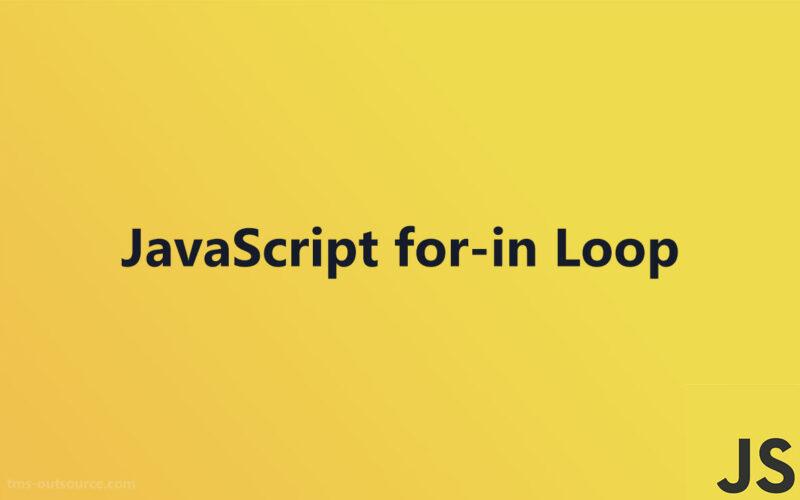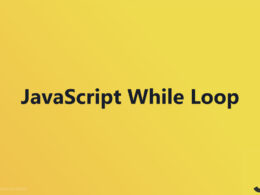Streamline Data Access with JavaScript’s for-in Loop

Navigating through object properties in JavaScript can be streamlined with the JavaScript for-in Loop.
This tool is essential for developers looking to efficiently iterate over properties, addressing both own properties and those inherited through the prototype chain.
Understanding its mechanics and best practices not only enhances code performance but also prevents common pitfalls associated with object iteration.
The JavaScript for Loop
Structure of the for Loop
When diving into the nitty-gritty of JavaScript loops, understanding the classic for loop syntax is pivotal.
The for loop is structured to repeat a block of code a certain number of times, which is ideal for tasks like iterating through arrays and processing data sequentially.
The syntax epithet consists of three key expressions:
- Initialization: Here, we typically define and set our loop counter to a starting value, like
let i = 0;. - Condition: This expression is crucial as it determines whether the loop will execute again. It checks a condition, generally against the loop counter, and continues the loop if the condition evaluates to true.
- Increment/Decrement: To modify the loop counter, we use an increment or decrement operator, such as
i++ori--. This adjustment happens at the end of each loop iteration.
Each part plays a critical role in controlling how and when the loop executes, ensuring it processes elements in an array or navigates through other data structures efficiently.
Practical Examples
Using for loop with arrays
The versatility of the for loop shines when working with arrays—where elements are neatly indexed. For instance, if you need to print each element of an array, you’d set up a loop that starts at zero (the first index in JavaScript arrays) and runs until it reaches the last index of the array:
let myArray = ['apple', 'banana', 'cherry'];
for (let i = 0; i < myArray.length; i++) {
console.log(myArray[i]);
}
This loop goes through each position in the array, accesses each item by its index, and performs an operation—in this case, printing to the console.
Nested for loops for multidimensional data
When dealing with multidimensional data, like arrays of arrays (common in tasks dealing with matrices or grids), nested for loops become indispensable.
They allow you to access and manipulate deeper layers of data structures:
let matrix = [
[1, 2, 3],
[4, 5, 6],
[7, 8, 9]
];
for (let i = 0; i < matrix.length; i++) {
for (let j = 0; j < matrix[i].length; j++) {
console.log(matrix[i][j]);
}
}
Here, the outer loop iterates over each sub-array in the matrix, while the inner loop cycles through the elements of each sub-array.
This pattern is essential for handling more complex data collections efficiently.
The JavaScript for-in Loop
Introduction and Syntax
When you need to iterate over the properties of an object, the JavaScript for-in Loop shines with its practicality and ease of use.
This loop goes through the properties of an object one by one in an arbitrary order.
The basic syntax for the for-in loop is straightforward:
for (var key in object) {
// code to execute
}
Here, key is the variable that represents the property name of object as a string during each iteration.
This makes the for-in loop particularly useful for exploring the properties and their values dynamically, especially when you might not know all the key names in an object.
Working of for-in Loop
The for-in loop not only accesses the object’s own enumerable properties but also iterates over the properties inherited from its prototype.
This aspect is crucial to understand because it can lead to unexpected results if the prototype chain of the object has additional properties.
Properly managing these inherited properties involves checking if the property belongs to the object itself and not inherited from its prototype.
The hasOwnProperty method is often used in such cases to ensure that only the object’s own properties are considered:
for (var key in object) {
if (object.hasOwnProperty(key)) {
// code to execute on object's own properties
}
}
Examples and Use Cases
The for-in loop is adept at handling different types of objects such as user-defined objects or built-in object types like Date and others. Consider this simple user-defined object:
var person = {
name: 'John',
age: 30,
city: 'New York'
};
for (var key in person) {
console.log(key + ': ' + person[key]);
}
This loop would print all the properties of the person object. However, when using this loop with array objects, caution is advised.
Arrays are also objects, but they are best processed with array-specific loops like for, forEach, or the modern for-of loop.
The reason is that the for-in loop iterates over all enumerable properties, which might include more than just the array elements, potentially leading to unexpected behavior if the array’s prototype has been modified.
The JavaScript for-of Loop
Understanding for-of Loop
The for-of loop provides a robust method for iterating over iterable objects such as arrays, strings, and other iterable types like Map and Set.
Unlike the JavaScript for-in Loop, which is used to iterate over the properties of an object, the for-of loop focuses on iterating over the values of an iterable object.
This distinction is crucial because it aligns the use of the loop with the type of data structure being managed.
For iterable objects like arrays and strings, where index-based access and order of elements are significant, for-of provides a direct, readable, and error-free syntax.
Code Examples
for-of with arrays
When it comes to iterating over arrays, the for-of loop helps eliminate common pitfalls associated with traditional for loops, including handling indexes and avoiding off-by-one errors.
Here’s a simple example:
let fruits = ['apple', 'banana', 'cherry'];
for (let fruit of fruits) {
console.log(fruit);
}
This loop directly accesses each element fruit of the array fruits without needing to use an index to point to the element.
for-of with strings to access characters
Strings are another prime candidate for the for-of loop, especially when you need to perform operations on each character. Here’s how you can easily loop over each character in a string:
let greeting = 'Hello';
for (let char of greeting) {
console.log(char);
}
Each iteration in this loop prints a character of the string greeting to the console, demonstrating the loop’s utility in handling characters of a string directly without the need for indexing.
Loop Control Statements
Importance of Control Statements
Control statements effectively steer the flow of execution within loops.
These are particularly handy when you have to cut short a loop or skip certain iterations based on specific conditions. The primary types of control statements used in loops are break and continue.
- Break: Immediately exits the loop, disregarding any subsequent iterations.
- Continue: Skips the current iteration and proceeds to the next cycle of the loop.
These tools are essential for managing complex loop conditions and avoiding unnecessary processing, making code more efficient and readable.
Strategic Placement of Control Statements
Examples of break
Here’s a practical scenario where break becomes useful.
Imagine looping through an array to find a particular element and stopping the loop as soon as that element is found to save processing time:
let numbers = [1, 3, 5, 7, 9, 12];
for (let number of numbers) {
if (number === 7) {
console.log("Found 7!");
break;
}
}
In this example, as soon as the number 7 is found, the loop terminates.
This prevents the loop from unnecessarily iterating over the rest of the elements, thereby enhancing performance.
Examples of continue
The continue statement is used when certain conditions within the loop are met, and you want to skip over the remaining part of the current loop iteration. Here’s how it can be implemented:
let numbers = [1, 2, 3, 4, 5, 6];
for (let number of numbers) {
if (number % 2 === 0) {
continue; // Skip even numbers
}
console.log(number); // This line only runs for odd numbers
}
In the above loop, continue skips the logging of even numbers.
Only the odd numbers are printed, demonstrating an efficient way to exclude specific conditions within a loop without breaking out of the loop entirely.
Best Practices and Common Mistakes
Best Practices in Using Loops
Understanding when to use each type of loop can greatly enhance your JavaScript code’s efficiency and readability.
Selecting the right loop type is based on the structure of the data you’re working with and the task you need to accomplish.
- For loop: Ideal for scenarios where the number of iterations is known before the loop starts, such as processing items in an array with a predetermined length.
- While loop: Best used when the number of iterations isn’t known in advance and the loop needs to continue until a certain condition changes, typically outside the loop’s control commands.
- Do-while loop: Similar to the while loop but guarantees that the loop body is executed at least once.
- JavaScript for-in Loop: Should be primarily used for iterating over object properties.
- For-of loop: The preferred option for iterating over iterable objects such as Arrays, Strings, Maps, NodeLists, and more, focusing on the values rather than the properties.
Performance considerations also play a crucial role, particularly in loops within loops (nested loops), which can significantly impact runtime, especially with large datasets. Efficient loop usage, including reducing unnecessary computations within loop bodies and selecting the most appropriate loop type, can result in smoother and faster code execution.
Common Mistakes
Infinite loops: These occur when the exit condition is never met. Common culprits involve incorrectly updating loop counters or misconfigured conditional statements. Always ensure your loop has a clear and reachable exit condition to avoid these costly errors.
Misusing loops over arrays with for-in: It’s a common mistake to use the for-in loop for arrays because it iterates over all enumerable properties, which can include more than just the array’s numerical indices and lead to unexpected results. For arrays, it is more appropriate to use the for, for-of, or Array.prototype methods like forEach, map, or filter.
Variable scope issues in loops: Using var inside loops can lead to unexpected behavior due to its function-scoped nature. var declared inside a loop can be accessed outside that loop. Instead, use let or const for block-scoped variables to avoid unintended interactions outside the loop scope, ensuring that each iteration retains its unique scope of any variables declared within.
Loop Scopes and Variables
Scope in JavaScript Loops
Understanding scope in JavaScript loops is crucial as it dictates the accessibility of variables declared within these loops. The var, let, and const keywords play diverse roles in how loop scopes are handled:
- var: Declares a variable that has function scope or global scope if declared outside any function. When used in loops,
varcan lead to unexpected behavior because the variable is accessible outside the loop as well. - let: Introduces block scope to JavaScript, meaning that variables declared with
letin a loop are only accessible within that loop iteration. This helps prevent common mistakes like accidentally accessing loop variables outside their intended scope. - const: Functions similarly to
letin terms of scope, but it also prevents reassignment of the variable value. It’s perfect for loop counters or other loop-related variables that should not change once initialized within the scope of the loop.
These distinctions are especially important in loops where the scope of a variable can affect the loop’s behavior and output. Being mindful of these differences ensures better control and fewer bugs in your code.
Examples Illustrating Scope
Practical examples using var and let in loops
Consider this loop where var is used:
for (var i = 0; i < 3; i++) {
console.log(i); // Outputs 0, 1, 2
}
console.log(i); // Outputs 3
Here, i is accessible outside the loop due to its function/global scope, which might not always be desirable.
Now, observe the behavior when let is used:
for (let j = 0; j < 3; j++) {
console.log(j); // Outputs 0, 1, 2
}
console.log(j); // Uncaught ReferenceError: j is not defined
In this case, j is not accessible outside the loop, preventing any unintended access and ensuring j is confined to the loop block. This confinement aligns with typical expectations and safe coding practices, particularly in complex scripts where variables could accidentally be reused or modified.
FAQ On JavaScript for-in Loop
What exactly does a JavaScript for-in Loop do?
The JavaScript for-in Loop effortlessly traverses properties of an object, looping over each one in no specific order. It’s particularly useful when you need to execute a block of code for every property, giving developers a straightforward way to handle dynamic objects.
How does the for-in loop differ from a for-of loop?
While the for-in loop iterates over object keys, the for-of loop is designed for iterating through iterable objects like arrays, strings, focusing diligently on their values rather than their properties.
Is the JavaScript for-in Loop suitable for arrays?
Typically, it’s not ideal. The for-in loop can iterate over array indices, but it encompasses all enumerable properties, which might include additional, unintended properties if the array’s prototype has been altered. For arrays, methods like forEach or for-of provide more predictable results.
How do you check if a property belongs directly to an object inside a for-in loop?
To ensure the property isn’t inherited, you can use the hasOwnProperty method within your loop. Like this:
for (let key in object) {
if (object.hasOwnProperty(key)) {
// Your code here
}
}
This practice secures that only the object’s own properties are considered.
Can you use break and continue statements inside a JavaScript for-in Loop?
Absolutely, both break and continue are usable within a for-in loop to control the flow based on the specific requirement. Using break exits the loop immediately, whereas continue skips the current iteration and proceeds to the next.
What are some common pitfalls when using a JavaScript for-in Loop?
Common issues include accidentally processing inherited properties without checks, leading to unexpected behavior, and using it on arrays where indexed methods are more appropriate. Developers should be mindful of unnecessary computations inside the loop as well, aiming for optimal performance.
What is the basic syntax of a JavaScript for-in Loop?
The syntax is concise and clear:
for (var key in object) {
console.log(key, object[key]);
}
Here, key will be each property name of the object as the loop iterates.
Can you modify the properties of an object in a for-in loop?
Yes, the properties accessed can certainly be modified or even completely replaced during iteration. This flexibility allows dynamic updates to the object based on real-time conditions or data processing requirements.
How do you ensure a JavaScript for-in Loop only iterates over enumerable properties?
The for-in loop naturally iterates over all enumerable properties, including those inherited. To limit it to the object’s own properties, you utilize the hasOwnProperty method to filter out unwanted inherited properties.
What are alternatives to using a JavaScript for-in Loop for object properties?
Alternatives include using Object.keys() or Object.entries() methods, which return an array of an object’s own property names or key-value pairs respectively, and then using array methods like forEach to iterate. This approach avoids the pitfalls of the for-in loop especially with inherited properties.
Conclusion
Exploring the JavaScript for-in Loop has unfolded the nuances of efficiently iterating over object properties.
Understanding when and how to deploy this loop ensures robust code management and helps to avoid common pitfalls like unintended property enumeration from prototype chains.
With key insights into utilizing hasOwnProperty for filtering properties and recognizing when alternative methods might be better suited to your needs, it’s clear that this loop is a powerful tool in JavaScript’s arsenal, essential for developers looking to write clear, effective, and optimized code in their scripting challenges.
If you liked this article about JavaScript for-in Loop, you should check out this article about JavaScript Events.
There are also similar articles discussing external javascript, javascript loops, JavaScript For Loop, and JavaScript While Loop.
And let’s not forget about articles on JavaScript For Of, JavaScript do…while Loop, javascript foreach loop, and JavaScript Versions.
- Essentials of JavaScript Functions for Beginners - June 22, 2024
- Exclusive Hip-Hop Mixes: Music Apps Like Datpiff - June 21, 2024
- Revolutionizing Software Testing: How AI is Transforming Quality Assurance - June 21, 2024








